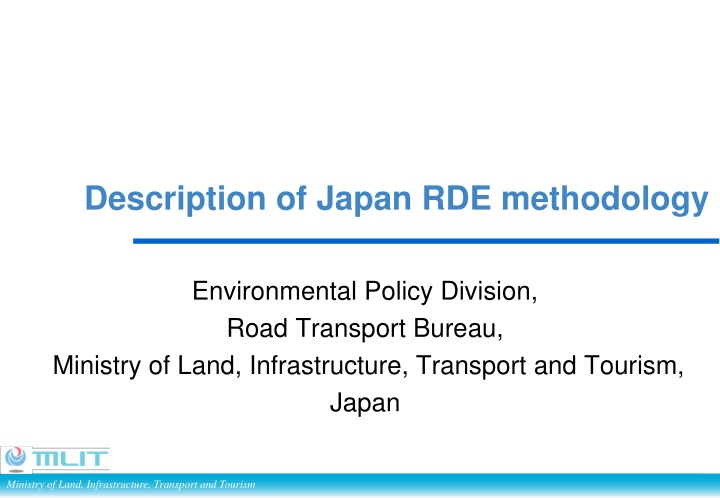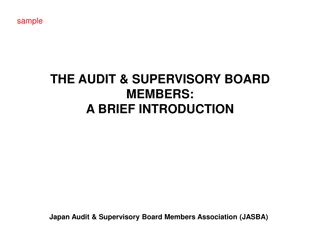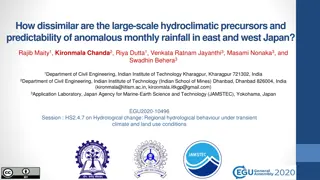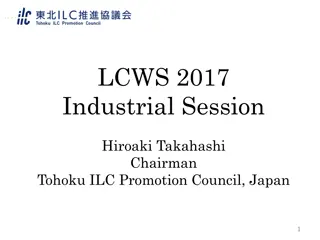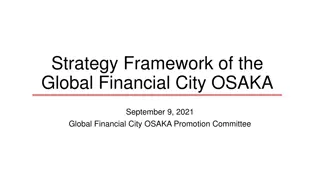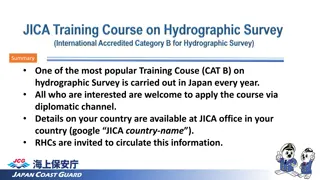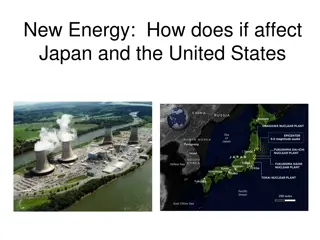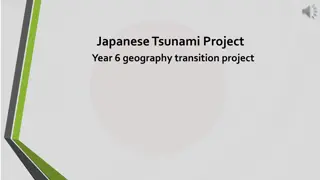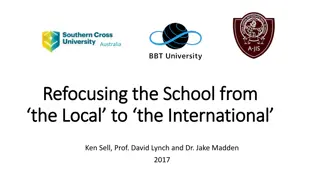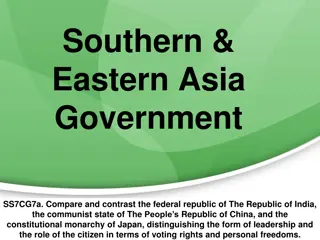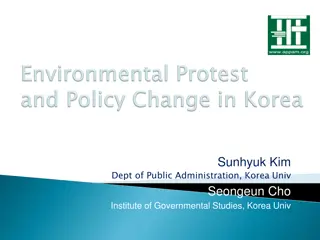Japan's RDE Methodology and Environmental Policy Overview
Japan's Road Transport Bureau under the Ministry of Land, Infrastructure, Transport and Tourism has outlined the methodology for Real Driving Emissions (RDE) testing in the country. This includes the scope, concept, and adaptation of RDE methods to reflect real-world driving conditions in Japan. The introduction schedule for RDE implementation, modifications in WLTP phases, traffic, and weather conditions specific to Japan are also highlighted.
Download Presentation

Please find below an Image/Link to download the presentation.
The content on the website is provided AS IS for your information and personal use only. It may not be sold, licensed, or shared on other websites without obtaining consent from the author.If you encounter any issues during the download, it is possible that the publisher has removed the file from their server.
You are allowed to download the files provided on this website for personal or commercial use, subject to the condition that they are used lawfully. All files are the property of their respective owners.
The content on the website is provided AS IS for your information and personal use only. It may not be sold, licensed, or shared on other websites without obtaining consent from the author.
E N D
Presentation Transcript
Description of Japan RDE methodology Environmental Policy Division, Road Transport Bureau, Ministry of Land, Infrastructure, Transport and Tourism, Japan Ministry of Land, Infrastructure, Transport and Tourism
Outline of RDE in Japan Scope Diesel vehicles having a gross weight of 3.5t or less Diesel powered passenger cars having a capacity of 9 or less people Method and Requirement [will be described later] Schedule of Introduction for RDE in Japan New Type Approval Vehicle : October 2022 Continuous Production Vehicle : October 2024
Concept of Japans RDE method RDE method shall be able to detect whether result of chassis-dynamometer test reflects on real driving correctly or not. The Japan s RDE method is based on EC s , but it is slightly modified considering different real world driving conditions and different phase of WLTC between Japan and Europe. Therefore, we modified these factors in align with driving conditions in Japan. 4
WLTP phases Japan are using 3 phases in WLTP. The average speed and max speed are greatly different between 3 phases and 4 phases. Based on these differences, Japan modified some factors slightly. Main differences between WLTC 3 phases and 4 phases 3 phases 4 phases Average Speed 36.6 km/h 46.5 km/h Ratio of Idling Time 15.4 % 13.0 % Max Speed 97.4 km/h 131.3 km/h Max Acceleration 5.7 km/h/s 5.7 km/h/s RPA 0.167 0.152 Driving Time 1477 s 1800 s Total Mileage 15.01 km 23.27 km 5
Traffic Conditions The traffic speed in Japan s real driving tends to be slow compared with World-Wide. Especially, the ratio of driving speed at 60km/h or less ( Low + Middle ) is very high. Since the speed limit of Japan s motorway is less than 100km/h in most sections, the proportion of EX-High is low. Traffic rate of Japan and World-Wide EX-High 5% Low 14% High 13% EX-High 34% Low 39% Middle 20% Middle 43% High 32% The speed thresholds are 60km/h, 80km/h, 110km/h.
Weather Conditions Japan is somewhat hotter than Europe. 98% of the traffic in Japan is between -2 to 34 , calculating from traffic frequency distribution weighted by traffic volume, time and temperature, excluding upper and lower 1%. In summer, the temperature near the vehicle increase about 4 . Increased temperature on the road Average traffic volume for every air temperature 2012-2016 Temperature near the vehicle Air temperature Yellow area is about 1% (low temperature and high temperature, respectively) 7
Structure of J-RDE method Japan s RDE is basically the same structure and method as EC s RDE. Japan s RDE method 1. Scope 2. Definitions and Abbreviations 3. General Requirements 4. Special Requirements 5. Test Conditions 6. Running Requirement 7. Driving requirement 8. Lubricating Oil, Fuel and Reagent 9. Emission Amount of Exhaust Emission and Evaluation of Running Appendix 1 Test Procedure for Exhaust Emission with PEMS Appendix 2 Specification and Calibration of PEMS and Signals Appendix 3 Validation of PEMS a Non-Traceable Exhaust Mass Flow Rate Appendix 4 Determination of Emissions Appendix 5 Verification of Trip Dynamic Conditions by Moving Average Window Appendix 6 Verification of Overall Trip Dynamic State Appendix 7 Procedure to Determine Cumulative Positive Elevation Gain of Trip Appendix 8 Verification of Trip Conditions of OVC- HEV and Calculation of Final On-Road Emissions 9
Different respects between J E WLTP phases Based on difference of WLTP phases, Japan modified some of factors slightly as below. J-RDE E-RDE Speed [km/h] Consist [%] Speed [km/h] Consist [%] Routes Routes Vehicle speed and Consist Urban V<60 29-44 Urban/Rural V 60 40-65 Rural 60<V<90 23-43 Motorway 60<V 35-55 Motorway 90<V 23-43 V<45 urban speed 45 V<80:rural speed 80 V<145:motorway speed Window speed characteristics V<50:urban/rural speed 50 V:motorway speed P1:vp1=18.882km/h (Average Speed of the Low Speed phase of the WLTP cycle) P2:vp2=56.664km/h (Average Speed of the High Speed phase of the WLTP cycle) P3:vp3=91.997km/h (Average Speed of the Extra High Speed phase of the WLTP cycle) P1 : Same as E-RDE CO2characteristic curve reference points P2 : Same as E-RDE P3 :
Different respects between J E WLTP phases J-RDE E-RDE 0.2 0.2 RPA RPA RPA 0.1 0.1 NG NG 0 0 0 20 40 60 80 100 120 km/h 0 20 40 60 80 100 120 km/h 30 30 NG NG Vapos_[95] Vapos_[95] 20 20 v 10 10 apos_[95] 0 0 0 20 40 60 80 100 120 km/h 0 20 40 60 80 100 120 km/h 11
Different respects between J E WLTP phases Based on difference of real driving condition, Japan modified some of factors slightly as below. J-RDE E-RDE 1.Urban 2.Rural 3.Motorway 1.Urban/Rural 2.Motorway Order Ambient conditions Altitude 0~1000m( 700m) (Moderate altitude) 0 ~1300m( 700m) (Moderate altitude) -2 (0)~38 (35) Moderate temp -7 (0)~ 35 (30) (Moderate temp) temp Average speed (urban driving part) 15 ~ 40 km/h Max speed 145km/h Cover range : 90 ~ at least 110 km/h Velocity : Above 100 km/h for at least 5 minutes. Motorway speed Test track Available
Different respects between J E WLTP phases Based on difference of regulation and concept, Japan modified some of factors slightly as below. J-RDE E-RDE NOx, CO2 Note: Japan doesn t regulate PN under the chassis- dynamometer test and on road test. Measurement items NOx, PN, CO2 The fuel, lubricant and reagent (if applicable) used for RDE testing shall be within the specifications issued by the manufacturer for vehicle operation by the customer. Basically same as E-RDE(If it exceed criteria, the reference fuel defined in Annex 3 of GTR15 may be used for second RDE test. ). Fuel It is basically the test may be invalid. However, it can be made valid if the CF value conforms to limit. If a part of the test is performed outside of ambient conditions The test shall be invalid.
Consideration of CO2 Characteristic Curve WLTC Low WLTC High
